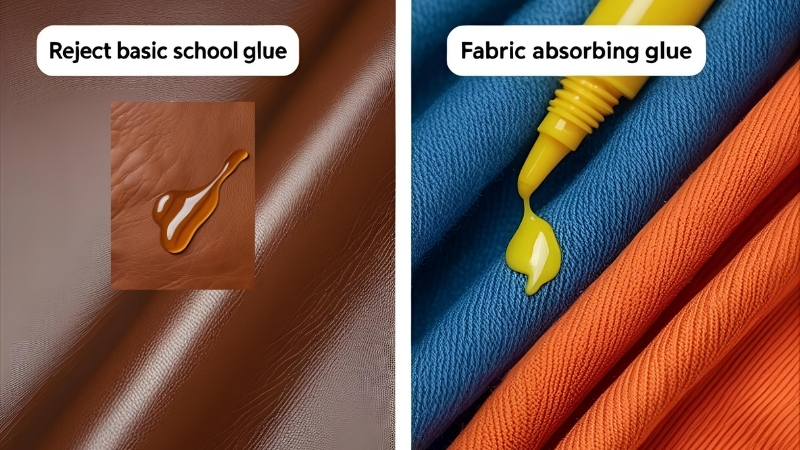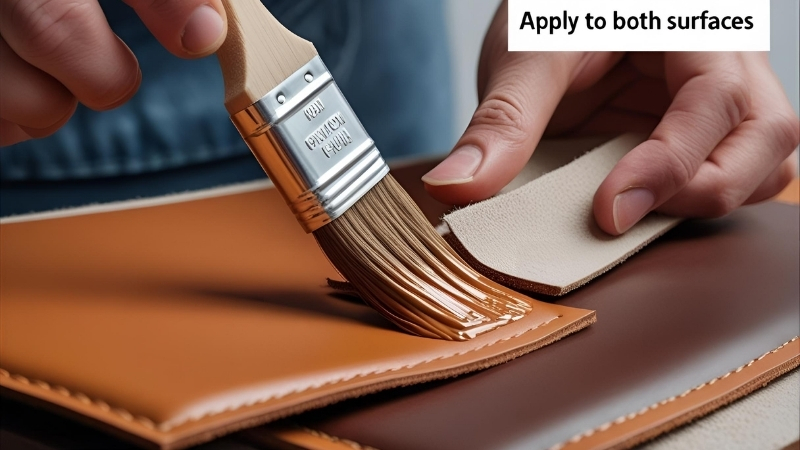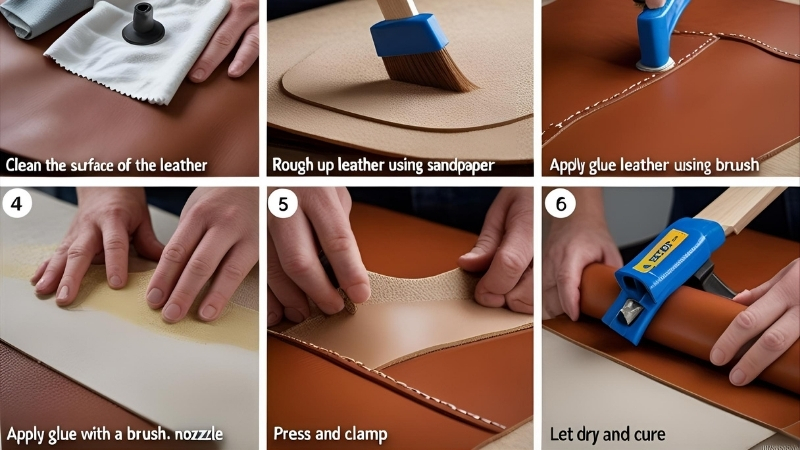Leather goods are meant to last—but when they tear, peel, or separate, the right glue can either save the day or make it worse. You can’t just grab the first adhesive in the drawer and expect it to work. Leather is a unique material with its own personality—it’s tough, flexible, and sometimes temperamental.
So if you’re wondering what glue actually works on leather, this guide will walk you through all your options with clarity, experience, and a little off-roader grit.
Why Leather Needs Special Glue
Leather may be rugged, but it’s picky about what sticks.
Let’s be clear – not all adhesives are created equal—especially when it comes to leather. The problem isn’t just finding a glue that sticks, but one that stays stuck without ruining the leather’s texture, flexibility, or look. That’s why understanding leather’s unique nature is the first step before even opening the glue cap.
Recommended Leather Glue: Check The Products
Here’s why using the wrong glue can backfire:
Natural oils interfere with adhesion
Leather contains natural fats and oils that can prevent glue from forming a solid bond. Standard glue may dry up or peel right off because of these oils.
It’s a flexible material
Unlike wood or hard plastic, leather bends and stretches. If your adhesive hardens when dry, it could cause cracks or stiff patches that ruin the look and feel.
Porous and finished surfaces vary
Some leather has a sealed, shiny finish, while others (like suede) are soft and fuzzy. Glues interact differently depending on the surface, so one-size-fits-all adhesives often fail.
Types of Glue That Work on Leather
Choosing the right glue depends on your project, the leather type, and how much movement the piece will see.
Some glues are perfect for shoes; others work best for crafts or delicate restoration work. Below, we’ll break down the most effective glue types for leather, so you can match the right tool to the right job.
1. Leather-Specific Glue
These glues are designed with leather in mind, making them the safest and most straightforward choice.
If you’re working on leather for the first time, this is a great place to start. Leather-specific adhesives like Aleene’s Leather & Suede Glue or Tandy Eco-Flo Leather Weld are formulated to stay flexible and bond securely to smooth or fuzzy leather surfaces.
Why they’re a great choice:
Flexible when dry
They dry with a soft hold that moves with the leather, so belts, shoes, or bags still feel natural.
Dries clear or matte white
You won’t get that crusty, yellow glue line. Perfect for visible seams or delicate repairs.
Water-based and safe
No harsh fumes or strong chemicals, so it’s ideal for indoor use or working with kids.
Best for: light repairs on jackets, wallets, craft projects, and decorative pieces
2. Contact Cement (Solvent-Based Impact Glue)
This is the heavy-duty champion in the world of leather adhesives.
When you need a bond that won’t budge—like gluing boot soles, belts, or saddles—contact cement is the go-to. Brands like Barge and Weldwood have been trusted by leatherworkers for generations because they create a super-strong, permanent bond.
What makes it special:
Bonds instantly when both sides are tacky
Apply to both surfaces, wait 10–15 minutes, and press. The pieces will lock together immediately—no clamping required.
Super strong, flexible hold
It doesn’t become brittle over time and holds up well under movement, stress, and moisture.
Long-lasting performance
Once cured, it’s water-resistant, heat-resistant, and nearly impossible to separate.
Things to watch out for:
Toxic fumes
Must be used in a well-ventilated area or outdoors with a respirator mask.
No second chances
Once the surfaces touch, they’re stuck—repositioning is impossible without ruining the bond.
Best for: repairing shoe soles, attaching thick leather panels, high-wear gear
3. Water-Based Leather Adhesives
If you want something safer, simpler, and less fussy—this is your match.
Water-based leather glues have grown in popularity among hobbyists, crafters, and even some professionals. While they may not be as heavy-duty as contact cement, they offer great workability and user-friendliness.
Why you’ll love them:
Low odor and nontoxic
You can work indoors without needing a gas mask—great for beginners or small home studios.
Slower drying time
This gives you time to reposition or fix mistakes before the glue fully sets.
Easy cleanup
If it drips or oozes, a damp cloth will wipe it away before drying—no damage done.
Limitations:
Not ideal for high-stress applications
Water-based glues are weaker compared to contact cement and can peel under pressure.
Best for: hobby leathercraft, wallets, keychains, leather-on-paper art
4. Cyanoacrylate (Super Glue)
Sometimes you just need something fast—super glue fits that niche, but it’s not without issues.
When you’re fixing a small leather accessory, like a fraying seam or leather trim, cyanoacrylate glues (like Gorilla Super Glue or Krazy Glue) can work surprisingly well. But they come with some serious trade-offs.
Why use it:
Ultra-fast setting time
Bonds in seconds—perfect for emergency repairs or when clamping isn’t an option.
Precision applicators
Small bottles and narrow tips allow for exact placement on tiny surfaces.
Downsides:
Dries rigid and brittle
Not ideal for flexible leather pieces. Over time, it can crack or snap under strain.
Can leave white residue
Especially on darker leathers, the dried glue might stand out or cloud the surface.
Best for: small accessories, rigid components, in-place seam fixes
5. Polyurethane-Based or Hot Melt Adhesives
These are the unsung heroes of heavy-duty and industrial leather projects.
Often used in factories or by professional cobblers, polyurethane-based adhesives (like PUR hot-melt glue) are known for their strength, durability, and flexibility. They’re especially useful for mixed-material applications like leather-to-rubber or leather-to-fabric.
What makes them powerful:
High heat resistance
These glues hold strong in extreme temperatures—great for work boots or outdoor gear.
Stays flexible after curing
Unlike super glue, these adhesives move with the leather over time.
Waterproof and weather-resistant
Designed for harsh environments, so your repairs can survive rain, mud, or snow.
Challenges:
Requires a hot melt applicator or glue gun
Not always convenient for home users unless you’re equipped for it.
Best for: boots, tactical gear, upholstery, rugged outdoor items
6. Animal Glue (Hide or Protein-Based)
This old-school adhesive still has a place—especially for restoration work.
Hide glue has been around for centuries. Museums and antique restorers still use it because it creates a strong bond that can be reversed with heat or moisture—ideal for delicate leather pieces you might want to undo or replace later.
Why go vintage:
Safe and natural
Made from animal collagen, it’s nontoxic and biodegradable.
Reversible bond
Unlike modern adhesives, this glue can be softened and removed without damaging the leather.
Traditional finish
Dries with a natural matte look that suits aged or untreated leather.
Best for: antique saddles, vintage leather books, museum restoration work
7. Craft Glues (E6000, Barge Cement)
These are popular among DIYers and leather crafters for their versatility and toughness.
Craft-focused glues like E6000 or the more industrial Barge Cement sit in a middle ground—they’re tough enough for wearables, yet flexible enough for regular use. But fair warning – they smell strong and require care.
Why choose them:
- Adheres to multiple surfaces: Leather, plastic, rubber, fabric—it’s a multi-purpose beast.
- Dries flexible and waterproof: Great for costume pieces or items worn outdoors.
- Strong and permanent: Once cured, it’s hard to break the bond.
Caution:
- Ventilation is key: These adhesives emit strong fumes—don’t use them in a small, enclosed space.
Best for: cosplay, bags, costume pieces, multipurpose leather repairs
How to Choose the Right Glue for Leather
Feeling overwhelmed? Let’s simplify. With so many options, it’s easy to get lost. But if you ask yourself a few key questions, the choice becomes much easier. Let’s break it down:
What type of leather are you working with?
Smooth, shiny leather reacts differently than suede or unfinished leather. Choose glue that’s rated for your leather’s surface.
How much flexibility do you need?
Is the leather going to bend, stretch, or stay rigid? Contact cement and polyurethane-based glues are great for flexible areas, while super glue suits rigid parts.
Is the glue going to be visible?
Go for clear-drying or white-drying options if you’re working on the surface. Dark glues may stain or leave marks.
Are you working indoors?
If you don’t have proper ventilation, water-based glues or leather-specific adhesives are safer to use.
How to Glue Leather Properly (Step-by-Step)
Great glue needs great technique. Even the best glue can fail without proper preparation. Follow these steps to make the bond last. Here’s how to do it right:
1. Prepare the Leather
Clean both surfaces thoroughly using a leather cleaner or rubbing alcohol. Roughen the contact area slightly using fine-grit sandpaper or a leather rougher to help the glue grip.
2. Apply the Glue Correctly
Apply a thin, even layer to one or both surfaces depending on the glue type. For contact cement, apply to both sides and let it dry until tacky.
3. Align and Press Together
Carefully line up both pieces—especially important for permanent glues. Press them together firmly and evenly.
4. Clamp or Apply Pressure
Use clamps, books, or weights to maintain consistent pressure for at least 30 minutes. For softer glues, leave them overnight.
5. Let It Cure Fully
Don’t use the item until the glue has cured fully. Some glues may feel dry but still need 24–48 hours to reach full strength.
Stick with the Right Glue
When it comes to leather, the wrong glue can ruin everything. But with the right one, your repair or project will look and feel seamless—literally. Whether you’re fixing a well-worn boot, repairing a leather couch, or crafting a wallet by hand, now you know exactly what to use and how to use it.
Your leather deserves better than trial and error. Now you’re ready to glue like a pro.




